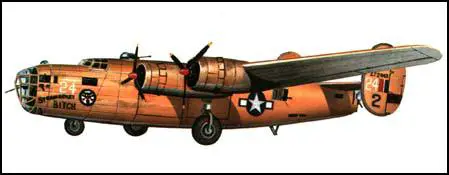B-24 Liberator
The Consolidated Aircraft Corporation began work on a new heavy bomber, the B-24 Liberator in 1939. However, it was not until April, 1942, that the Liberator went into combat. It had a maximum speed of 303 mph (488 km) and had a range of 2,850 miles (4,585 km). It was 66 ft 4 in (22.22 m) long with a wingspan of 110 ft (33.52 m). The aircraft, which had a crew of eight, was armed with 10 machine-guns and could carry 8,800 lb (4.000 kg) of bombs.
It had greater operational range than the B-17 Flying Fortress and a total of 19,203 Liberators were built between 1942 and 1945. In three years it dropped 635,000 tons (635 million kg) of bombs and brought down 4,189 enemy aircraft. As well as the United States Air Force the Royal Air Force also ordered 1,694 and saw service with Bomber Command during the Second World War.

Primary Sources
(1) Gordon Taylor flew a Liberator when he first trained as a pilot for the RAF.
The Liberator was a popular aircraft which; could fly over the weather, was fast, and could easily do Gander to Prestwick non-stop without going in to Greenland or Iceland for fuel. It was always outrageously overloaded, several tons above its designed gross weight. Furthermore, it had a very fine-sectioned wing which used to flex in alarming fashion in turbulent air. It frankly frightened me, and I could not ignore the thought that in very turbulent cloud a wing might fail: in fact several Liberators did disappear at night in bad weather on the South Atlantic crossings. In San Diego, California, I later met a man who had been intimately concerned with the design of the Liberator wing. Pinning him down, I explained that I. had flown this aeroplane, very overloaded, and had not been happy to see the wing flex so much in turbulent air; so would he please explain to me just how it stayed on. He looked at me with a cynical smile and in a soft but significant drawl remarked, "That's something I've been trying to figure out myself."
